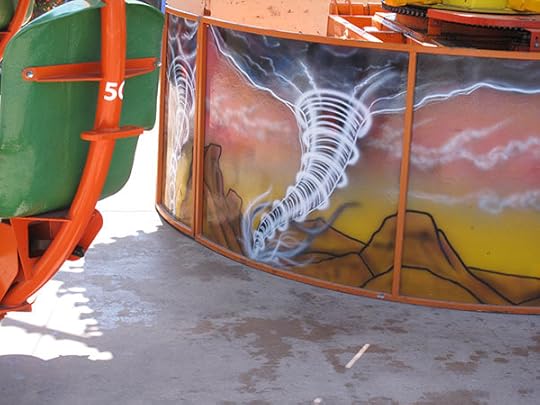Drifting Point of View
Today's post drifts through several topics.

My new book Jim and the Flims got a nice review on the webzine Tor.com. The book's out in hardback and Kindle format now.

Our daughter Georgia was out here last month. We spent one afternoon painting together, dressed in in my hobo-like no-worries-about-smudges painting clothes. I was working on a picture of a landscape with my painter friend Vernon, and Georgia was working on a picture of me painting the picture of Vernon. A regress! (I'll post the picture of Vernon next week.)

I also started a new abstract that looks kind of like two olives. This is only a snapshot of a preliminary draft.
The thing with abstracts is that usually right at the beginning after only a little bit of work, the picture looks really great. But I don't want to stop then, I want to have more painting fun. So then I ruin the picture. And then I spend the next few weeks trying to fix it. This is in fact a kind of typical process in painting: A beautiful start, you ruin it, and from then on you're trying to fix it…and once it's okay, maybe you ruin it again, and paint some more.
I very rarely abandon a picture and just scrape it off. I think it's kind of nice to have the layers accumulate and to keep adding more. Throwing good paint after bad. My new goal, suggested by Paul Mavrides, is to try and build up a thicker texture on my canvases. Let me remind any newcomers that my painting are for sale, either as originals or prints. Sell it, Ru.

I wrote a story, "To See Infinity Bare," with my pal Paul DiFilippo in August, 2008. It was in some measure inspired by the image in the film Amadeus of the great Mozart being buried in a sheet in a public grave. And by James Blish's cool 1954 story, "Beep." The vicissitudes of publishing are such that "To See Infinity Bare" has appeared only now, three years later. In any case it's in a very nice anthology, Postscripts #24/#25 from the redoubtable PS Publishing.

The other day I saw my writer friend Karen Fowler, and she remarked that T. C. Boyle's 2003 Drop City was perhaps the best 1960s book she'd read.
So I finally got around to reading Drop City myself. Boyle has a beautiful style, and the characters are nicely developed (if maybe a little too clearly good guys or bad guys). But it was a total page-turner, I hadn't read a book like that for quite awhile. The plot was nicely woven, like macramé you might say. I like when I have a book like that, as then I don't have to worry about what to do with my spare time—I just lie on the couch and read more!

Boyle's hippie characters are very much like the characters in Thomas Wolfe's 1968 The Electric Kool-Aid Acid Test. Maybe there's only one way to write those characters.
The only thing I didn't quite like about the book was the number of violent scenes. These Hollywood-type fist-fights with one guy's arm raising and lowering like a piston as he repeatedly slugs his felled enemy in the face. In reality I've never seen a fight like that in my whole life, and Drop City has probably a dozen. People really don't do that kind of thing very often, and those passages are kind of dull, like porno or dream journals.
But other than those very few pages, it's a wonderful book, and it really does bring back the past for this old hippie.

I'm nearing the home stretch on my work in progress, The Turing Chronicles. I'm about to write a double-length chapter called "Nonlinear Feedback."
Up till now I'd planned for two separate chapters here, but then I got the idea that it would be richer if could shuffle two chapters together.
The chapter title "Nonlinear Feedback" expresses the kind of flow I'd like to see. One weird kick after another, each kick jolting the next one to a higher level than anticipated. Each kick adding nonlinear feedback.

Given that I have two chaps worth of material, it's a little hard to wrestle it into shape in my outline. For awhile I had a structural idea of using a kaleidoscopic approach and structuring the chapter as a series of short pops, with each POP from a different point of view.
When I say "pop," I'm thinking of a string of firecrackers going off.
So I wrote out a list of pops a few days ago and printed out the list and cut them apart with scissors and shuffled them by hand, Burroughs-cut-up style, and that made me excited.
And then I rearranged my electronic text to match the pasted-up cut-up, and it wasn't quite right, so I did, like, four more rewrites of the chapter outline, and in the process I smoothed away the potentially jarring section breaks.

And then I got into clarifying the chapter's timeline, nailing down the date and time for each event, to help master the flow. With a complex chapter like this, it's all about finding a way to control the material. Thinking in terms of point of view and of timeline are two different ways to chunk the material at a higher level.
Regarding point of view, I will in fact switch points of view repeatedly during the chapter, but I'll be using the risky "drifting point of view" favored by Philip K. Dick (and by amateur writers). I'll be using a third-person narration, but getting close-in on the current viewer, kind of looking through their eyes. It is possible to make the drifting POV work, but it's tricky. Ordinarily I prefer having like "***"-type section breaks to signal the shifts. But doing the drift sets me a new challenge and that keeps the game interesting.

The carrot drawing me on is that pretty soon I get to send Alan Turing into a really huge bomb explosion. The V-bomb which may or may not generate a ray to turn everyone in the U.S.A. into a skugger! Did I mention that The Turing Chronicles is a 1950s Invasion Story?
Rudy Rucker's Blog
- Rudy Rucker's profile
- 583 followers




